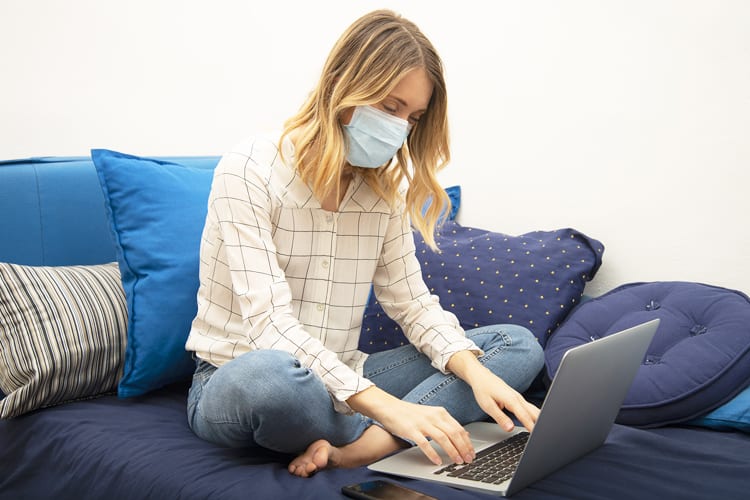What You’ll Need at Home During a Quarantine

As COVID-19 impacts more parts of the country, our approach to the virus changes almost daily. Widespread quarantines once sounded far-fetched, but now self-quarantining is urged by politicians and medical professionals. Things are moving quickly and it can be hard to keep up, but the faster people adapt the more lives will be saved.
The best we can do is stay calm, and follow the advice of medical experts like the CDC and the WHO. As of now, that means outside of a handful of essential worker categories we all need to self-quarantine. Even seemingly healthy people should stay inside whenever possible since some people can carry the disease without ever showing symptoms but can be a carrier. It’s a complex, rapidly changing situation, but it’s clear that the best way we can do our part is by quarantining.
But what does a quarantine look like? Here’s what you need to know about quarantines, as well as what you should have at home if you’re stuck inside indefinitely.
The Basics of a Quarantine
You’ve heard three different terms lately that all amount to staying inside, but for different reasons.
- Social distancing: Avoid gatherings, physical interactions, and contact with anyone that’s not part of your household. Stay six feet apart in public. In practice, social distancing amounts to staying at home unless you need to go to work, the grocery store, the pharmacy, or somewhere else critical. Everyone should practice social distancing during a pandemic.
- Quarantine: Whether imposed by yourself or the government, quarantine is basically when you put your life on lockdown. If you feel sick or think you’ve come into contact with the virus, consult with your insurance or check the CDC site for steps. You should self-quarantine and self-monitor for two weeks, and avoid leaving home or making contact with others at all. Knowing that many people with the virus are asymptomatic, many health officials recommend quarantining under any circumstances. States are shifting to Shelter-In-Place or Safer-At-Home policies that only allow essential businesses to stay open.
- Isolation: If you were to start feeling sick or test positive for the virus, you would go into isolation at home or the hospital as ordered by the doctor. Anyone in isolation should wear a mask, and only leave home to go directly to a medical facility.
In the next few weeks, almost all Americans could find themselves quarantined, but not everyone is prepared to stay inside for up to two weeks.
Stocking Up for a Quarantine
If you haven’t prepared for quarantine yet, you should make a run to get food, medicine, and other supplies as soon as possible. While trying to social distance, it’s a good idea to try to avoid busy grocery stores. If you can, shop at off-peak hours and avoid getting too close to other shoppers. Try to observe the six-foot social distancing rule at the store too which some stores are putting tape on the ground to help assist where to stand.
Start by taking stock of what you have and making a list of what you need.
Essential items for a two week supply:
- Food and water
- Prescription
- Over-the-counter-medicine
- Items for your elderly household members or pet(s)
Most people have more toilet paper than they need, so use this calculator to figure out how long your current supply can last you.
When you get to the store, shelf life matters. A good stock of dried, canned, and frozen foods will last you a few weeks, even in a worst-case scenario. Pasta, cereal, and other non-perishables are smart purchases as well. You can still get perishables like chicken and beef, but be cognizant of when you should use them by.
Depending on what’s left in stock at your local store, pick up disinfectant wipes and hand sanitizer, as well as some fresh hand soap. Washing your hands regularly is an important way to keep yourself safe, as well as prevent the spread of the virus if you get infected. If you can’t find any hand sanitizer at the store, you can make your own at home too.
If you’re not comfortable going out in these conditions, many stores are offering grocery delivery options via online orders. Others have special hours where the elderly, pregnant, and other vulnerable groups to minimize their potential contact with infected people. Whenever possible, take advantage of these protective measures designed to slow the spread of coronavirus.
If you have to go out, consider even wearing a mask to protect yourself and others from spreading the virus. Fabric and paper masks are relatively easy to make at home. Avoid buying up medical masks unless you’re sick since infected people and medical professionals need to be able to get masks.
Your mental health matters in quarantine too. Weeks of separation from the people in your life can put a serious strain on you, so find ways to stay occupied while stuck inside. A well-stocked pantry is obviously important, but a well-stocked bookshelf can help you get through quarantine too. If you need some inspiration on how to keep busy, we put together a list of some great things you can do for free, from home.
The Bottom Line
While it all still might sound like a sci-fi plot, many Americans will have to face quarantines in the coming weeks and/or months. Even if you don’t feel any symptoms of COVID-19, you should still be conscious of social distancing and quarantining. You may be young and healthy, but anyone can pass the virus, without showing severe symptoms, to someone more vulnerable.
When quarantined, you may feel like you’re all alone, but know that you’re doing your part to help the country get through this virus as quickly as possible.









